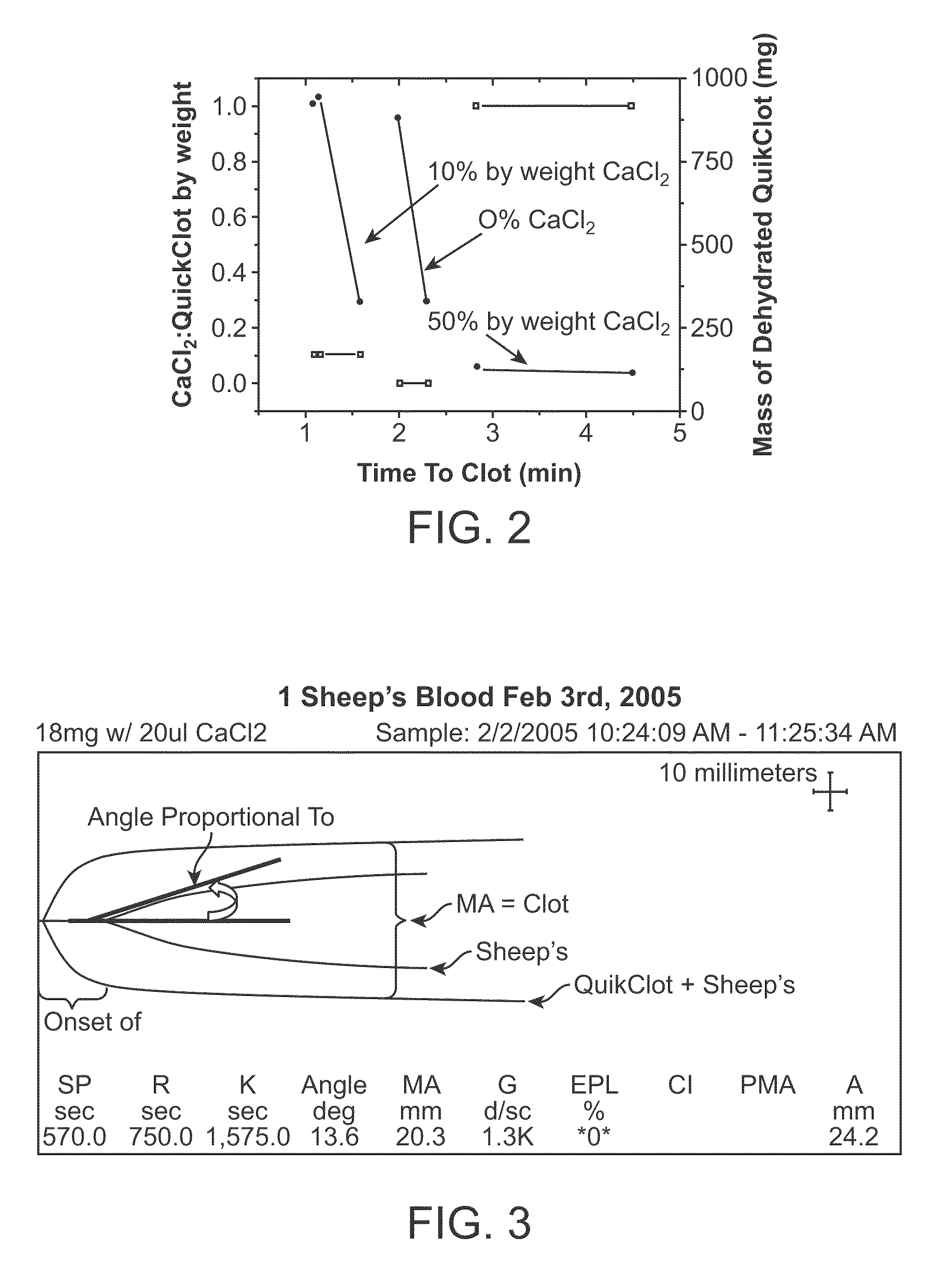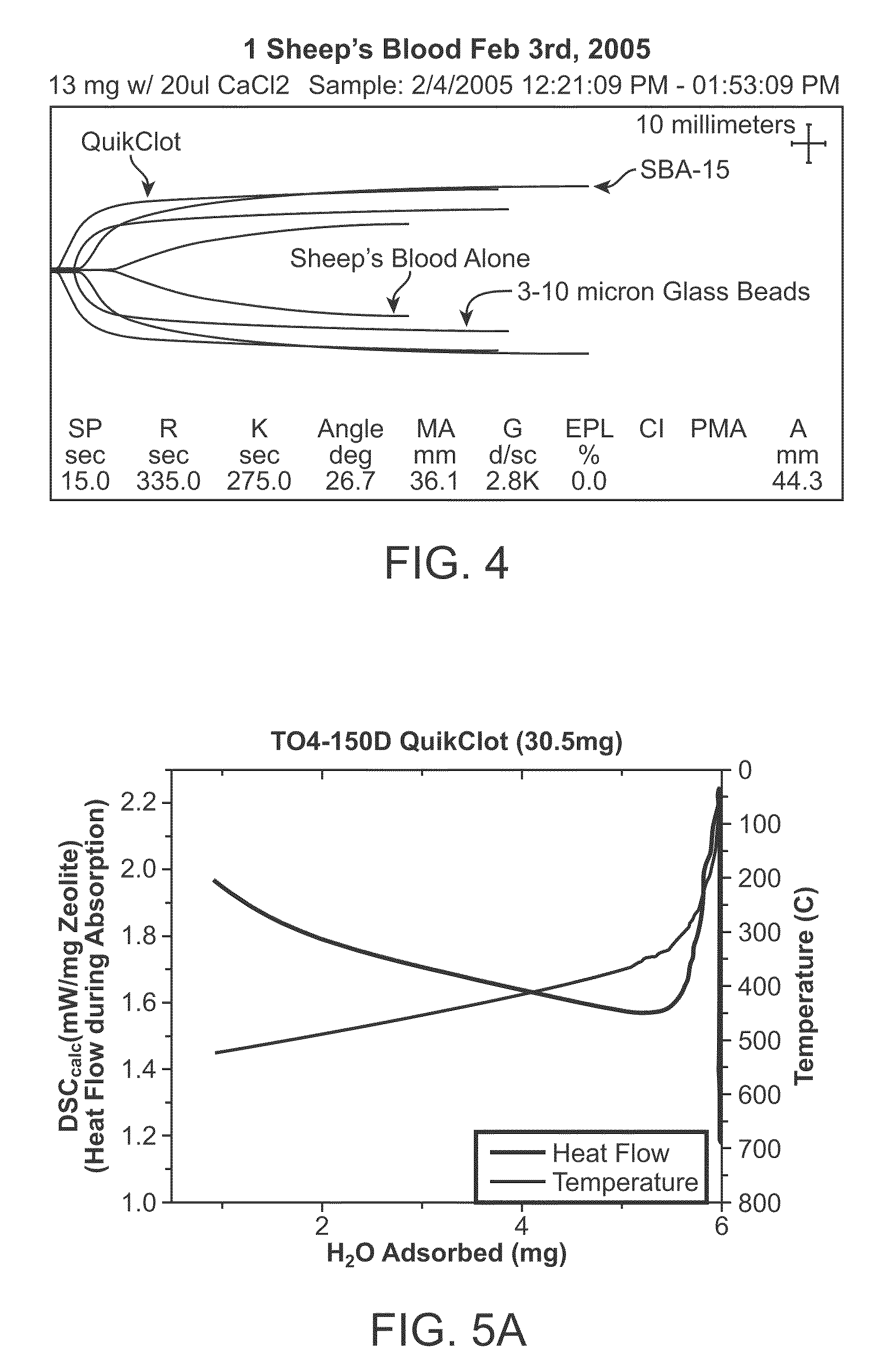Inorganic materials for hemostatic modulation and therapeutic wound healing
a technology of inorganic materials and wound healing, which is applied in the direction of drug compositions, medical preparations, peptide/protein ingredients, etc., can solve the problems of excessive heat generated locally at the injured site, and achieve the effects of reducing the heat of hydration, and attenuating the side effects of tissue burning
- Summary
- Abstract
- Description
- Claims
- Application Information
AI Technical Summary
Problems solved by technology
Method used
Image
Examples
example 1
Formulations of Porous Inorganic Materials for Therapeutic Wound Healing
[0073]This example describes ion exchanged formulations of QuikClot® that reduce the heat of hydration by 5 to 40%. FIGS. 1A-1B show differential scanning calorimetry plots that demonstrate a reduced hydration enthalpy for the ion exchanged formulations. Formulations include mixtures of ion exchanged zeolite Linde Type A with inorganic salts including, but not limited to, calcium chloride (CaCl2) aluminum sulfate (Al2(SO4)3) and silver nitrate (AgNO3).
[0074]The hydration enthalpy of zeolites is related to the cations present in the zeolite (Yu, B L et al. Thermochimica Acta, 200 (1992) 299-308; Drebushchak, V A J Thermal Anal Calorimetry 58 (1999) 653-662; Mizota, T et al. Thermochimica Acta 266 (1995) 331-341). Typically, larger and less charged cations tend to have a lower hydration enthalpy. Additionally, the hydration enthalpy of a zeolite relative to the amount of water adsorbed has been found to decrease w...
example 2
Hemostatic Effects of Glass and Prehydration: Antibiotic Activity
[0078]This example describes a new class of materials (silaceous oxides and ceramics) which can be co-formulated with QuikClot® or applied directly alone for hemostatic efficacy. In addition, we have substantiated an antibiotic response from QuikClot® towards a typical Gram Negative bacteria.
The Glass Effect
[0079]QuikClot® is comprised of a dehydrated zeolite that is applied to the site of traumatic vascular hemorrhaging. At the time of contact with the blood, a large amount of heat is generated at the same time that the zeolite absorbs and sequesters fluid phase components from the blood matrix. It has been observed in our laboratory that, in addition to dehydration and heat generation, there is selective absorption of blood components to the zeolite surface as well as disruption of the local electrolyte concentration. Our initial understanding of the interaction between the four parameters: heat released upon hydrati...
example 3
Host-Guest Composites for Induced Hemostasis and Therapeutic Healing in Traumatic Injuries
[0087]In this example, two strategies for reducing the large amount of heat released by a zeolite-based hemostatic agent (HA) during application have been described and quantified: 1) ion exchange and 2) prehydration. Five ion-exchanged derivatives of the original HA have been prepared and assayed for hemostatic efficacy both in vitro, by TEG®, and in vivo, by clinical swine trials. Contact activation coagulation rates, α, were found to increase with the amount of heat released by the HA. In vitro clot induction time, R, and HA surface area have been identified as predictors of in vivo hemostatic performance. A proposed rationale for selecting hemostatic materials based on these parameters will likely reduce the quantity of experiments involving animals, and the associated labor and capital costs, necessary to test a new HA. A method for incorporating antibacterial activity against gram negativ...
PUM
| Property | Measurement | Unit |
|---|---|---|
| particle size | aaaaa | aaaaa |
| particle size | aaaaa | aaaaa |
| particle size | aaaaa | aaaaa |
Abstract
Description
Claims
Application Information
 Login to View More
Login to View More - R&D
- Intellectual Property
- Life Sciences
- Materials
- Tech Scout
- Unparalleled Data Quality
- Higher Quality Content
- 60% Fewer Hallucinations
Browse by: Latest US Patents, China's latest patents, Technical Efficacy Thesaurus, Application Domain, Technology Topic, Popular Technical Reports.
© 2025 PatSnap. All rights reserved.Legal|Privacy policy|Modern Slavery Act Transparency Statement|Sitemap|About US| Contact US: help@patsnap.com



